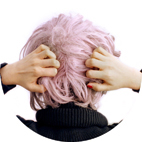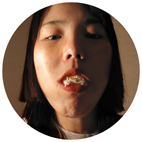|
The Lenticularity of Sung Yeon Park
- Wandering round in between the gap of visual khora
Young Jin Gwon
Art Historian
  
Sung Yeon Park is interested in what is ¡®seeing¡¯. It is probably natural that she is sensitive about the issue of ¡®seeing¡¯ as she is an artist who majored in visual arts in undergraduate and graduate school. However, Park¡¯s interest in ¡®seeing¡¯ begins at the point of perception and cognition of the human eye. She questions the self identity formed through this process of recognition, and challenges the series of conventional categories.
Park¡¯s work begins with the criticism of the visual system that has controlled us for a very long time. It is natural that anyone who works with visual media should be sensitive about the issue of ¡®seeing¡¯, and so is Park. She is not free from the antagonism between the reality perceived by the eye, and the unreality judged by the eye.
Let alone the history of visual perception and deductive thinking which has been controlling the human life for many centuries, Sung Yeon Park¡¯s works are full of questions on the meaning of ¡®seeing¡¯, the system of thoughts built upon the issue, and the questioning of herself as a visual artist. The digitally scanned image of Alice in Wonderland and the distorted image from the reflecting mirror are full of questions and doubts on the well established belief on our vision.
Park seems to be unsure of her duty as a visual artist who is required to promptly reproduce what she sees. She also questions her status as a member of the modern society who is required to promptly live and function. Whereas in the past, the reflected image from the mirror was the beginning of her question, her new work features lenticular images. These are adequate means to question the border between reality and unreality, as well as the visual system that recognizes the things we perceive as accurate.
Park likes to take photographs, but she finds the monocular representation of the visual environment rather strange as oppose to ¡®accurate¡¯. On the contrary, the lenticular image is produced by the vision influenced by the distance between two eyes. This parallex produces 3-D perception of the visual environment. However, our system of visual perception is overly used to the scientific image produced by the monocular lens of optical cameras.
Sung Yeon Park ¡¯s lenticular images demand the correction of this monocular perspective of the visual system. This monocular perspective that has been ruling our visual perception means singularity and uniqueness that lead to constancy and unity. Humans are beings of light and logic. The vision-centered thinking of modern men has already occupied our cognitive system. ¡®Vision¡¯ based on ¡®light¡¯ is the evidence for idealism based on dialectical thinking and heliolatry of modern men. This eliminates the factor of material changeability of the human body, which is generally considered feminine. The invisible domain needs light in order to exist. Otherwise it will be deleted by the logic of light and dialectics.
In the works of Sung Yeon Park , seeing is recognizing. This causes an articulation of the self identification process. The viewer will experience a visual disturbance while looking at Park¡¯s lenticular images. This also leads to the confusion of the world they had taken for granted. The changes in the lenticular images depend upon the point of view and movement of the viewers. This is a more multiple experience compared to that caused by a single photographic or video image. This is a constant disturbance to the monocular perspective. The conventional images rejected the existence of our binocular eyes and forced us to see a single image. However, Park¡¯s lenticular images confirm the entity of our binocular eyes. It is a process of multiple visions through two eyes.
Lenticular images are produced by cutting the images into equal pieces and rearranging them. These images are singular and multiple at the same time. They are unreality mixed with reality. They can be unreal for they are based on reality. They are a sequence of movements on a single plane. Sung Yeon Park intends to show the dream within reality and the reality within dream through this animated image on a still frame. Park¡¯s lenticular images compulsively repeat images of a woman vomiting noodles or a man drowning. The woman cannot finish vomiting the noodles. The man cannot drown nor escape. They continue to repeat their actions just like Sisyphus.
The images we know, the images formed by what we see will be helpless against the lenticular images of Sung Yeon Park . Her images move from this to that, and from dream to reality. However they are much too vivid to become strange and forgotten as the images we wee in our dreams. The lenticular work by Park is a strange self-identification process of reaffirming oneself before the forced reality and knowledge.
Plato¡¯s concept of khora indicates the surplus that cannot be verified by linguistic activities. Khora rejects logos. It can be recognized neither by sensation nor cognition. Park constantly tries to reveal the incoherence of our visual thinking through her works. Her works are just like the khora, which is left out as a surplus that cannot be explained through light and logic. They are grounded on our visual functions, yet cannot be explained by logical thinking nor described in words. They are a part of the world outside the world of language. They will continue to repeat themselves just like the unreal world of dreams.
|












